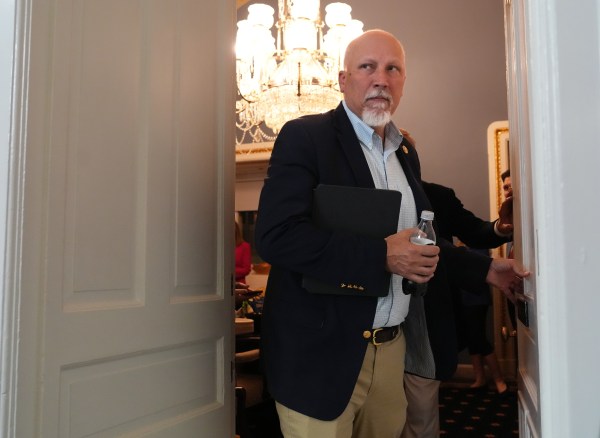The congressional redistricting that follows America’s decennial census is always a messy process. As populations shift, congressional districts shift too, with the result often looking like a frantic game of musical chairs—one in which the party in power tries to redraw the map to give itself as many seats as possible, the party out of power denounces such actions as despicable anti-democratic tricks, and incumbents sweat over whether the constituency they’re ending up with will be as amenable to them as the one that elected them in the first place.
But redistricting has been particularly chaotic this year, thanks to a 2020 census that limped along months behind schedule (there was that pandemic going on). You can’t draw new legislative maps until you know where all the people have ended up; in many places, maps aren’t yet in their final form, but congressional primaries are fast approaching anyway, complicating intraparty rivalries.
Cast your eye, for instance, out to North Carolina, one of six states to gain a new congressional district once the census results were in. The new map, approved by the Republican legislature last year, makes a few changes to the westernmost part of the state. The old, heavily Republican 11th District, represented by Rep. Madison Cawthorn, has been renumbered the 14th with a few minor tweaks. The bigger change is the new 13th District, which takes a chunk of the old 5th and shaves off some particularly Republican parts of the 11th to create a new, safely Republican seat.
That’s not to say the new 14th isn’t still solidly Republican, too. Once upon a time, the old 11th was one of the most competitive districts in the state: Republican Bill Hendon and Democrat James Clarke spent the 1980s kicking one another out of office every few years. But later maps painted the 11th much redder, paving the way for the rise of Mark Meadows—who represented the district from 2013 until leaving in 2020 to become President Donald Trump’s chief of staff—and then Cawthorn, who became the youngest federal lawmaker in the nation at the age of 25.
So it took North Carolina Republicans completely by surprise when Cawthorn abruptly announced late last year that he’d decided not to run again in his own district at all. Instead, he said, he’d be hopping one district east, into the greener pastures of the new 13th. “We are taking ground for conservatism,” Cawthorn said in a video statement. “Knowing the political realities of the 13th District, I’m afraid that another establishment, ‘go along to get along’ Republican would prevail there. I will not let that happen.”
Some elements of this statement were mysterious. The primary “political reality” of the 13th District—practically the whole reason for its construction—is that it’s a safely Republican district, slightly more so than Cawthorn’s own.
“A Republican would be more tempted to appeal to moderates in the 14th than they would in the 13th” going by the district’s partisan makeup alone, Christopher Cooper, a professor of politics at Western Carolina University, told The Dispatch. The 13th, by contrast, is “the kind of district that doesn’t really encourage squishy Republicans, because if they get squishy they’ll get primaried. So I don’t really think that’s a logical explanation for what Cawthorn was doing.”
Other parts of the statement, however, were crystal clear. The state party faithful had no trouble sussing out whom Cawthorn was denouncing as a “go along to get along” Republican: Tim Moore, the current GOP speaker of the state legislature. It was an open secret among party operatives that the new 13th had been drawn specifically so that Moore, who has served as speaker since Thom Tillis vacated the position to become a U.S. senator in 2015, could make his own triumphant turn into national politics.
The immediate problem was obvious. Cawthorn’s 2020 win had drawn national media attention, and not just because of his age. There was his dramatic personal story—a 2014 car crash robbed him of the use of his legs—and there was the fact that Cawthorn successfully ran an outsider-insider playbook to victory over a candidate, Lynda Bennett, who had been endorsed both by Meadows and by President Trump. Put it all together, and pretty much everyone was reaching for the same descriptor for Cawthorn: rising GOP star.
That label has stuck, despite a number of scandals Cawthorn has weathered since—the discovery of lies he’d told to make his personal story more poignant, accusations of inappropriate sexual behavior dating back to his one-semester tenure at Patrick Henry College, and the speech he gave at the Stop the Steal rally on the National Mall on January 6 of last year, hours before the storming of the Capitol. Cawthorn hasn’t secured any legislative victories during his first term, but he has forged strong alliances with some of the Trumpiest voices in the House GOP.
“Madison Cawthorn has aligned himself with the most Trumpian point of view in the Republican Party,” J. Michael Bitzer, a professor of politics and history at North Carolina’s Catawba College, told The Dispatch. “And if people don’t buy full-scale into that belief system, then they are going after fellow Republicans.”
He’s a formidable opponent, in other words, in at least one political arena: the Republican congressional primary.
Following Cawthorn’s announcement, Moore’s political trajectory changed literally overnight. It had seemed unlikely he would face a serious primary challenge—he was already one of the most powerful Republicans in the state, and his own conservative record was unimpeachable from any angle. He could hold his head high among social conservatives, having cosponsored the transgender “bathroom bill” that made North Carolina a national lightning rod in 2016. He’d played hardball with the Democratic governor on fiscal issues, overruling a veto of the state budget on multiple occasions. He’d put in the work and the time, and his path to Congress seemed clear—and suddenly here was one of Trumpworld’s favorite congressmen angling for a primary fight, implicitly accusing him of being a RINO. Just one day later, Moore announced he would seek another term in the state House.
By all accounts, it was the safe play. The main reason every intra-Republican fight boils down to who’s better at accusing the other of squishiness is that there’s no coming back from it; as soon as you start defending yourself, you’ve lost anyway, since the base hates it when you look weak. And it’s not like Moore isn’t well-positioned to fight another day: Dallas Woodhouse, the former executive director of the North Carolina GOP and current writer for state conservative paper Carolina Journal, pointed out to The Dispatch that Moore can still do plenty to burnish his credentials at the state level. But he didn’t hide his disdain for Cawthorn’s setting his sights on a fellow Republican with an unimpeachably conservative record.
“It’s natural for us to be defensive of people who have gone in and spent a decade now of crafting solid, conservative public policy and implementing it,” Woodhouse said. “It goes beyond just that he’s outspoken. We who sort of believe in public policy and believe that our elected officials in the legislature have done a good job over a certain amount of time, I think there’s some of us that refuse to accept the redefining of conservatism to mean being a loudmouth with no accomplishments over Republicans who are conservative and have a record of governance.”
What of the notion that Cawthorn is, in pushing Moore out of the race, taking on the state’s conservative “establishment”? “It kind of gives me flashbacks,” Woodhouse said. “Like, I ran the Republican Party. And there was always, when we would have chairman’s elections, you know, ‘we don’t want somebody from the establishment. We need someone not part of the establishment.’ I’m like, ‘We’re the party. You do realize that the very second somebody gets elected as a Republican party officer, you are by definition the f—ing establishment? You can’t not be!”
Cawthorn’s office did not respond to a request for comment.
Amid all this jockeying over who’s running where, there’s one more crucial fact that bears contemplating: North Carolina’s redistricting might not be over yet. The map produced last year by the state legislature—the map at the center of all this jockeying and maneuvering—is currently facing a challenge in state court on the grounds it is heavily gerrymandered to favor Republicans. (In 2020, Donald Trump won the state with less than 50 percent of the vote and Republicans won eight of 13 House races, but the new map favors a Republican to win in more than 70 percent of the state’s congressional districts.) The state’s Supreme Court has a 4-3 partisan lean favoring the Democrats, so it’s not unlikely the map will end up being remanded back to the legislature to cut state Democrats a better deal.
If that were to happen, two facts would be important. The first is that, while the 14th District is relatively hard for redistricting mapmakers to fiddle with—squeezed as it is into the far western corner of the state—the 13th, where Cawthorn is now running, is much less tamperproof, since it bumps right up against the 9th—the Democrat-heavy district that contains the city of Charlotte.
“If Republicans have to change the congressional map, which is highly likely, that 13th District is likely to become enormously less friendly to Republicans,” Woodhouse said. “And the reason is, if you try to protect your incumbents to the degree you can, and you’ve got to make changes somewhere, that leaves you the 13th. And the 13th, because it connects to Mecklenburg [County], can be altered a lot by taking a bunch of Charlotte Democrats and putting them in the 13th.”
The second is that, in this scenario, no single person would have more control over the final makeup of the map than North Carolina’s speaker of the House—Tim Moore.
Cawthorn’s gambit could easily pay off. If things go his way, he’ll have shown he can win multiple places, flexed his muscle in the state GOP, and moved into a district closer to the Charlotte media market—all benefits for a young lawmaker who’s made very clear he has his sights set on statewide office. (“I would love to be governor at some point,” he said during a talk at Western Carolina University last October.)
But the state’s unsettled redistricting picture threatens to throw a wrench in those plans. It may come to pass that Cawthorn’s political fate falls into the hands of the very man he’s trying to shove aside.
“Maybe the fact that we’re trying to use logic to make a determination of what Madison Cawthorn is doing—” Bitzer said, “maybe the fault, dear Brutus, lies with us.”






Please note that we at The Dispatch hold ourselves, our work, and our commenters to a higher standard than other places on the internet. We welcome comments that foster genuine debate or discussion—including comments critical of us or our work—but responses that include ad hominem attacks on fellow Dispatch members or are intended to stoke fear and anger may be moderated.
With your membership, you only have the ability to comment on The Morning Dispatch articles. Consider upgrading to join the conversation everywhere.